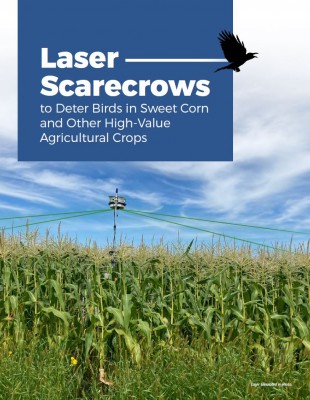Laser Scarecrows to Deter Birds in Sweet Corn
Julie Kikkert, Team Leader, Extension Vegetable Specialist
Cornell Vegetable Program

Are you considering the use of a laser scarecrow to deter birds on your farm? Cornell Cooperative Extension and the University of Rhode Island teamed up to test a research laser scarecrow on sweet corn farms.
A laser scarecrow is a device that has one or more laser modules connected to motors. The specifications of the lasers are optimized to the color and motion sensitivity of bird's eyes. When laser beams move across a field, birds become frightened and attempt to move away from the perceived threat. Light from the laser covers an area quickly and moves through the canopy without causing injury to the crop. Research demonstrates that birds do not readily become habituated to the laser.
A laser scarecrow used as the sole deterrent typically results in a significant reduction in crop damage. Combined with an auditory device, damage can be reduced even more. When used as part of an integrated management program for bird control that utilizes habitat management and multiple scare tactics, laser scarecrows can be useful tools for growers of multiple crops. All scare tactics must be deployed before birds find the field. The effectiveness of lasers depends on multiple factors such as bird species, bird populations, habitat and food availability. Lasers are not effective at deterring deer, racoons, coyotes or other mammals.
To learn more, the Laser Scarecrows to Deter Birds in Sweet Corn and Other High-Value Agricultural Crops fact sheet provides background information, research data, FAQs, and Advantages/Limitations on laser scarecrows.
Laser Scarecrows to Deter Birds in Sweet Corn and Other High-Value Agricultural Crops (pdf; 1316KB)

Upcoming Events
2025 Potato Advisory Meeting
December 16, 2025
Canandaigua, NY
Come hear the latest on insect pest control and fertility management in potatoes from Cornell University experts. Potato variety trial updates will be shared too. After lunch will be the Empire State Potato Grower's Meeting. 1.5 DEC credits in 10, 1a, and 23.
2026 Finger Lakes Produce Auction Winter Growers Meeting
January 8, 2026
Penn Yan, NY
At this vegetable grower-focused meeting, ag industry experts will discuss food safety, disease management in strawberries, the benefits of using cover crops, plus more. Two grower panel discussions will focus on pest management techniques and irrigation. DEC recertification credits offered in categories 10, 1a, 21, 22, 23, and 24.


































